
GSTR – 10 FAQ’s
What is the deadline for getting registered under GST?
An entity liable to be registered under GST should apply for registration within 30 days of meeting the criteria. Casual taxable persons and non-resident taxable persons are required to be registered under GST prior to commencing business.
Who is the primary authorized signatory?
The primary authorized signatory is the person who is primarily responsible to undertake tasks on the GST portal on behalf of the taxpayer. It could be the promotion of the business or any other trustworthy person nominated by the promoters of the business.
Is PAN mandatory for obtaining GST registration?
Yes. PAN is mandatory for obtaining GST registration. In the case of proprietorship, the PAN of the proprietor can be used. In the case of LLP or Company or Trust or other types of a legal entity, PAN must first be obtained for the entity. However, PAN is not mandatory for the GST registration of foreigners and foreign companies. For non-resident taxable persons, GSTIN with a fixed expiry date will be provided based on the other documents provided to prove existence.
What is the validity of GST registration?
GST registration does not have an expiry date. Hence, it will be valid until it’s cancelled, surrendered or suspended.Only GST registration for non-resident taxable persons and casual taxable persons have a validity period that is fixed by the authorities while issuing the GST registration certificate.
Can a person with no GST registration collect GST?
No, only persons registered under GST are allowed to collect GST from the customers. A person not registered under GST cannot even claim the input tax credit on the GST paid.
What is GSTR-10?
GSTR-10 is a final return required to be filed by taxpayers who have opted for cancellation or whose registration has been cancelled, surrendered or has lapsed.
How does GSTR-10 work?
GSTR-10 works by allowing taxpayers to declare their total tax liability during the period of registration and submit their returns accordingly.
Who needs to file GSTR-10?
Taxpayers who have opted for cancellation or whose registration has been cancelled, surrendered or has lapsed need to file GSTR-10.
When is the due date for GSTR-10?
The due date for GSTR-10 is 30 days from the date of cancellation/surrender of registration.
What information is required to file GSTR-10?
The information required to file GSTR-10 includes details such as the taxpayer’s GSTIN, date of cancellation/surrender of registration and total tax liability during the period of registration.
Is GSTR-10 available online?
Yes, GSTR-10 is available online through the Goods and Services Tax Network (GSTN) portal. IndiaFilings can help you file GSTR-10 quickly and easily,
How can I file GSTR-10?
GSTR-10 can be filed online through the GSTN portal.
Can I make corrections to GSTR-10 after filing?
Yes, corrections can be made to GSTR-10 after filing.
Is there a penalty for late filing of GSTR-10?
Yes, there is a penalty for late filing of GSTR-10. You will be charged Rs. 100 CGST and Rs. 100 SGST per day.
Does the GSTR-10 return need to be filed every year?
Only those whose GST registration has been cancelled or surrendered are needed to file GSTR 10 and it is a one-time process.
How do I check the status of my GSTR-10 filing?
You can check the status of your GSTR-10 filing by logging into your GST portal account and navigating to the Returns tab. Select View Returns/Payments and search for GSTR-10. You can view the status of your filing from the search results.
Are there any exemptions from filing GSTR-10?
Yes, certain businesses are exempt from filing GSTR-10. For example, businesses registered under the Composition Scheme, Input Service Distributors and Non-resident taxable persons are exempt from filing GSTR-10.
What documents should I keep for GSTR-10 filing?
The documents you should keep for GSTR-10 filing include GST Invoices, GST returns, GST challans, GST credit ledger and GST debit ledger.
How do I access the GSTR-10 portal?
You can access the GSTR-10 portal by logging into your GST portal account. The GSTR-10 portal can be found under the Returns tab.
What is the difference between GSTR-10 and GSTR-9?
GSTR-10 is a Final Return which needs to be filed by a registered person to report the details of GST taxes paid, input tax credit availed, and other details. GSTR-9 is an Annual Return which needs to be filed by a registered person to report the details of GST taxes paid and input tax credit availed during the financial year.
What is GSTR 10?
GSTR 10 return is mandated by the Goods and Services Tax (GST) in India. It’s a final return filed by registered taxable persons whose GST registration gets cancelled or surrendered. It essentially acts as a statement of the taxpayer’s stock holdings on the day before the cancellation becomes effective.
How to file GSTR 10?
The following is the brief process on how to file GSTR 10: To file GSTR 10 on the GST portal, log in, navigate to Services > Returns > Final Return, and update your address. Then, enter details of your stock holdings and preview the return before submission and payment.









Average Rating